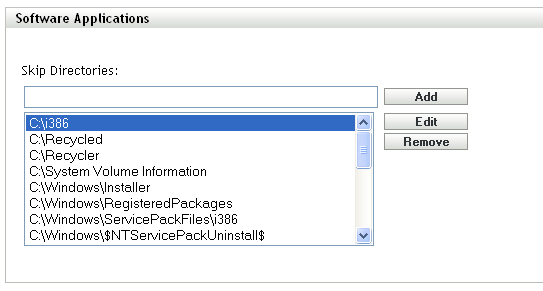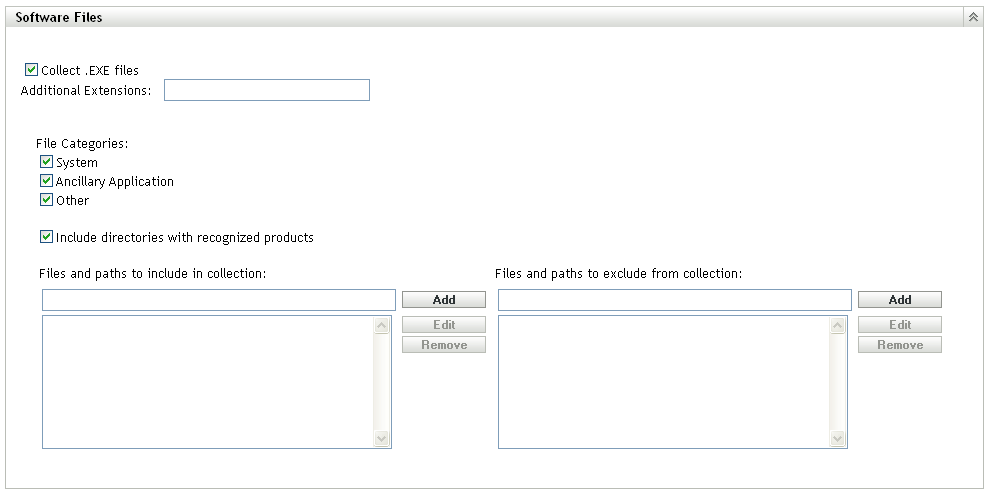3.1 Configuring an Inventory Only Scan
An inventory only scan allows you to collect data from devices in the Management Zone that only have the Inventory Only Module installed. By default, the inventory settings are preconfigured.
To configure an inventory only scan:
-
Click , then in the Management Zone Settings panel, click .
-
Click in the category list.
-
In the Server Refresh Interval panel, set the interval time in days, hours, and minutes.

The server handles requests from devices that have the Inventory Only Module installed, providing files for the settings, scan schedule, and so on. The interval setting determines how often the server evaluates the next scan schedule and when to obtain other settings. The server needs to poll the database at frequent intervals to pass on any changes that affect the devices.
The refresh interval should be set so that refreshes occur more frequently than scans. The default is 15 minutes.
NOTE:Ensure that the time interval of the Collection Server sending over data to the Primary server is lesser than the time interval of the managed devices sending over data to the Collection Server. For example, if Managed device M1 sends data to Collection Server every 12 minutes, configure the Collection Server to send data to the Primary server every 8 minutes.
-
In the Device Refresh Interval panel, set the interval time in days, hours, and minutes.

The Device Refresh Interval determines when the device checks the server for a change in settings, the schedule for the next scan, the ZENworks Knowledgebase for inventory, and new agent executables.
The refresh interval should be set so that refreshes occur more frequently than scans and less frequently than server refreshes. The default is 12 hours.
-
In the Scan panel, configure how you want to run the scan.

Collect Software Applications: Select this option if you want to scan for software applications installed on the device. This setting is selected by default.
Collect Software File Information: Select this option if you want to scan for software file information that can be used to identify software products that are not recognized by the ZENworks Knowledgebase. If you plan to create Local Software Products and add them to the knowledgebase, this option must be selected. For more information, see Section 6.0, Creating Local Software Products.
Collect Demographic Data: Select this option to gather demographic data from an inventoried-only device. This data is gathered from a file on the local machine. For more information, see Section 4.6, Scanning Demographic Data on an Inventory Only Device.
Run DMTF Translator: Select this option if you want to run the DMTF (Desktop Management Task Force) Translator. The DMTF translator converts the inventory data to formats that can be used by other tools and puts it on the local machine.
-
In the Software Applications panel, configure which directories to skip.

Skipping directories is useful in limiting the scope of the scan. The directories in the list are skipped.
-
To add a directory, specify a directory in the field, then click .
-
To edit an existing directory, select the directory, click , edit the directory, then click .
-
To delete an existing directory, select the directory and click .
-
-
In the Software Files panel, configure which types of files to scan for.

Software applications discovered in an inventory scan are identified by specific files associated with the product. These identifications are kept in the ZENworks Knowledgebase. To identify products that aren’t in the knowledgebase, you can search for files that are associated with an unrecognized product and use the file information to create a new product identification called a Local Software Product. This Local Software Product information can then be merged with the knowledgebase so that these new products are recognized in subsequent scans. For more information, see Section 6.0, Creating Local Software Products. To configure the file types, do the following:
-
To search for files with an .exe extension, select the option.
-
To search for files with a different extension, specify the extension in the field. Separate each extension with a + sign, for example, com+dll.
-
To scan for particular file types, select from the following:
-
System: Select this option to search for system files. This category is selected by default.
-
Ancillary Application: Select this option to search for files that are ancillary to, or associated with, a product that is recognized by the ZENworks Knowledgebase. This option is useful to create a comprehensive scan. This category is selected by default.
-
Other: Select this option to search for all other files. This category is selected by default.
-
-
To include directories with products that are recognized by the ZENworks Knowledgebase, select . This is useful to create a comprehensive scan.
-
To limit the scope of the scan by including and excluding files and paths, configure which files and paths to include or exclude from the collection by using and to specify which files and paths you want to include and exclude from the scan. You can edit the files and paths in the list by selecting the file or path and clicking . If you specify a file or path in the field, the scan is limited to just that file or path. If a file or path is specified in the field, all files and paths are searched except the specified file or path. Paths specified in the panel are also skipped.
-
-
In the Advanced panel, configure diagnostic settings.

WARNING:These options are intended for advanced diagnostics. Use them only under the guidance of a Novell Support representative.
-
In the Collection Servers panel, use the and buttons to arrange the collection servers.

This arrangement determines the order in which the collection servers receive the inventory data.
-
Click or .